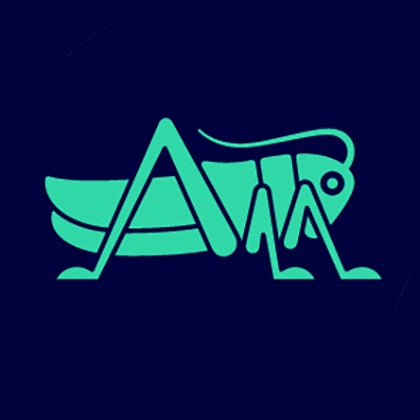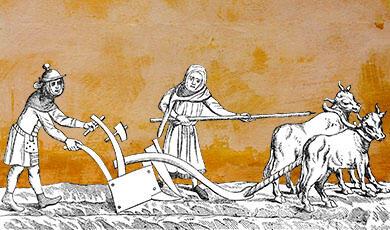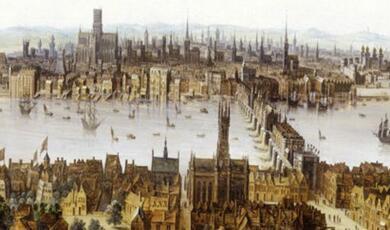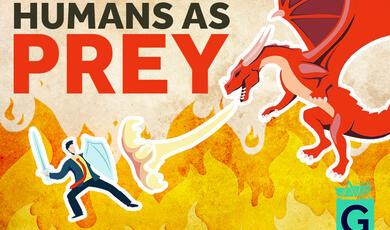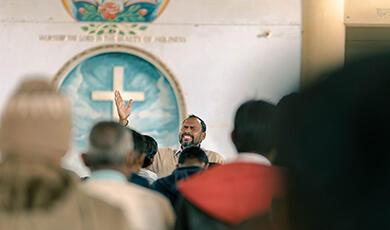How Does Mathematics Last? Heritage and Heritage-making in Mathematics
Share
- Details
- Text
- Audio
- Downloads
- Extra Reading
How is mathematical knowledge recorded and preserved across generations? Contrary to the idea that mathematics itself is somehow ‘permanent’, in this talk we will explore heritage-making in mathematics, that is the people, institutions, and material objects that can give mathematical ideas longevity. We will explore the heritage-making found in two very different types of French nineteenth-century libraries: those of famous mathematicians and those of secondary schools. We will especially focus on how the recording – and forgetting – of mathematical ideas is influenced by their publishing, political, and intellectual contexts.
Download Text
How does mathematics last? Heritage and heritage-making in mathematics in French libraries of the 19th Century
Professor Caroline Ehrhardt
8 October 2025
Introduction
In mathematics, certain knowledge developed hundreds of years ago is still studied today, and an idea that has been forgotten for decades can sometimes come back and find itself at the forefront of current research. How is this possible? How is mathematical knowledge recorded and preserved across generations? Contrary to the idea that mathematics itself is somehow ‘permanent’, mathematical ideas owes it longevity from the people who study and use them, from scholarly and teaching institutions, and from the material objects in which they are embodied. There are many mechanisms used by mathematicians to ensure the endurance of their work, from drawing connections between different areas of mathematics, relating new results to already established ideas, or attributing values of simplicity, clarity, or applicability to their work. However, for this new knowledge to endure over time, it must be able to circulate and the material conditions for its preservation must be ensured. It is these mechanisms of preservation and conservation that I propose to describe as process of heritage making, and that I examine from the perspective of cultural and social history, highlighting aspects of collective memory, heritage, and forgetting.
In this talk, I will focus on a particular case of heritage-making in mathematics, namely that which takes place thought libraries. Why focus on libraries in particular? It is clear that a library is a place for preserving and transmitting knowledge. In mathematics, certain books have acquired such a high status that they continued to be studied long after they were written, and remained for decades, even centuries, indispensable works for learning mathematics. Euclid's Elements is certainly the most famous example of this phenomenon. By making such books available to students, teachers and pupils, libraries have thus contributed to the creation of a long-standing teaching tradition. Libraries are also a place for creating knowledge, since it is from the collections stored there that future generations of scholars develop new knowledge. This is even more true for mathematics. Indeed, it is often said that the library is ‘the mathematician's laboratory’[1], and this expression highlights a distinctive feature of the discipline: the ‘material’ that mathematicians work from and with is not physical objects and instruments, but the books and journals that libraries make available to them. One example that comes to mind is Fermat's theorem, stated without proof in the 17th century in the margin of his copy of Diophantus' Arithmetics, itself written in the 3rd century AD, and which was only proven in 1995 using the most recent developments in number theory.
In this talk, I will explore the heritage-making in mathematics found in two very different types of French nineteenth-century libraries, contrasting the private libraries of famous mathematicians, such as Joseph-Louis Lagrange and Jean-Baptiste Delambre, with those of secondary schools. Through these two case studies we will see how the recording of mathematical ideas – and conversely, their forgetting – are influenced by their publishing, political, and intellectual contexts. Finally, I will present emerging themes and questions on heritage-making in mathematics opened up by the collective project "Heritage and Patrimonialisation of Mathematics (18th-20th Centuries)".
Libraries of 19th Century mathematicians
Among the ‘miscellaneous announcements’ published in 1823 in the Bulletin général et universel des annonces et nouvelles scientifiques, also known as Férussac’s Bulletin, one can read a description of a ‘library of mathematics, philosophy, physics and chemistry’ containing ‘1,500 to 1,600 volumes’ and having belonged to the mathematician and deputy to the Convention Nationale Louis François Antoine Arbogast (1759-1803). The anonymous author of the notice specifies, with regard to the mathematics books:
"In terms of mathematics, there are few amateur libraries more complete; it can provide enough material to write the history of science and contains many rare works. In addition to the academic collections of Paris, Berlin, Saint Petersburg and Turin, it contains the original authors from the birth of mathematics to the beginning of this century such as Euclid, Archimedes, Diophantus […], Cardan, Viète […], Descartes, Mersenne, Fermat […] Wallis, Neper […] Newton, Leibnitz […] Moivre, Taylor, Varignon […] d’Alembert, Cramer, Mac-Laurin […] Lagrange, Laplace […] the journals of the École Polytechnique and the École Normale, the history of mathematics by Montucla and Bossut, etc."[2]
There are no more precise traces left from that library than the long list of seventy-two authors of mathematical works, ranging from Euclid to Laplace, including Descartes, Newton and d'Alembert (to name but a few famous names) hidden by the ellipsis in the quotation. The announcement of the sale of such a collection in a journal intended for a scholarly audience nevertheless reveals a phenomenon that deserves attention: the interest that scholars of the early nineteenth century, particularly mathematicians, had in building libraries specialising in their field, in owning rare and antique books and, symmetrically, the importance that the sale of such collections could have. Few libraries belonging to 19th-century mathematicians have been preserved in their physical form, but the book sale catalogues compiled upon the death of the owner provide another source for gaining an insight into the mathematical documentation owned by these scholars.[3] In my recent research,[4] I have therefore taken an interest in the book sale catalogues of a dozen French mathematicians, who all belonged to the Académie des Sciences and/or a prestigious higher education institution (Collège de France, École Polytechnique) and lived between the second half of the 18th century and the last third of the 19th century.[5]
Of course, catalogues are only imperfect reflections of libraries, since not all books were put up for sale, and conversely, some may have been added to the catalogue by the bookseller in charge of the sale. However, this commercial context gives us access to another type of information, which is also linked to the issue of heritage making: the price of books on the second-hand market tells us both about the status of such specialised works from a bibliophile's point of view and about the mathematical uses they may have had. My aim in studying such catalogues is then to try to recreate the intellectual environment that gives meaning to the presence of mathematics books in these private libraries, whether as a result of individual taste or need, scholarly habitus, cultural immersion or even an economic windfall effect.
A first observation is that the mathematics books owned by mathematicians are not necessarily books that they read or use. Some of them are purchased for their bibliophilic value, while others have been received as gifts without having been particularly desired. However, their libraries remain closely linked to their social identity as mathematicians. This is evident, for example, in the presence in almost all libraries of books with strong symbolic value as disciplinary markers, even though they are not likely to be used in everyday work. Such books thus belong to a common mathematical heritage, in the sense that their possession is considered indispensable by mathematicians of the 19th Century.
A second observation is that while the creation of a library is not solely for scholarly purposes, one can find several traces of the use mathematicians made of their books in the catalogues, through the notes they took on the pages, the bindings they had made, or the owning of works that were instruments of mathematical work, such as numerical tables.
A third observation is that the mathematicians' libraries attest to a significant coexistence of the knowledge of the past with that of the owners' contemporary mathematics. All libraries contain works attributed to authors who lived before the 17th century, and among these authors, a core group of some twenty Greek and Latin scholars appear in all catalogues – sometimes in old editions, but more frequently in more recent reprints. In general, publishing success fuels the preservation of knowledge, since the most common authors prior to the 18th Century are not those considered to be the best known today, but those whose books were most widely published at the time. Finally, the ‘present’ of 19th-century mathematics can undoubtedly be traced back to the early 18th century, with authors born after 1700 being by far the most numerous in the catalogues. This can be explained both by the topicality of the knowledge and its wider dissemination, particularly via new media such as academic memoirs and then scientific journals. The sale catalogues thus show how the scientific value of knowledge and the material availability of its medium interact in the creation of posterity and cultural heritage.
Libraries of French Secondary schools (1795-1837)
The analysis of the catalogues of secondary school libraries offers a complementary perspective. The history of libraries in French secondary schools in the early 19th century lies at the crossroads of two profound transformations initiated by the Revolution. On the one hand, general reforms to the education system led to the widespread teaching of mathematics and, in particular, the writing of new textbooks such as Lacroix’s ones. On the other hand, the confiscation of church property resulted in millions of books being stored in literary repositories with a view to their subsequent redistribution.[6]
When the Ecoles centrales were created in 1795 to replace the colleges of the Old Regime, the Council of Public Instruction drew up a list of recommended mathematics books. This moment is a typical example of heritage making, since it was decided what books would be preserved and given legitimacy, and what would be consigned to the dustbin of the history. The mathematics books recommended were mostly recent publications, typically from the second half of the 18th century. The reason was not the topicality of the knowledge they contained, since they were fairly more or less elementary books. In fact, these books were first recommended because of their conformity with what was considered the correct way of presenting things, that is, in the words of the committee, ‘the spirit of analysis’ they exemplified. The second reason for recommending these books was pragmatic, it was their suitability for teaching contexts, and above all their availability or their price.
However, the government's ambitions went beyond the basic teaching of mathematics. As explained in the official text, libraries ‘should not limit theirselves to elementary books’ but were supposed to bring together ‘the best that this science has produced, both in pure mathematics and applied mathematics […]’. Although the archives are very incomplete in this regard, we can assume that this goal was not actually achieved. As mathematics was rarely taught under the Old Régime, the vast majority of the Ecole centrales were unable to obtain locally the books that their teachers would have liked to have. Some of them requested books to to the literary repositories in Paris, but, in practice, few were available since they had been given in priority to major scientific educational institutions. In fact, the most interesting and recent books in mathematic that had been confiscated from the clergy and nobility were generally reallocated to the École Polytechnique, rather than to the Ecoles centrales.[7] As a consequence, the books chosen in Paris and brought back to the Ecoles centrales contributed to the creation of a local heritage that was somewhat at odds with the mathematics promoted by Parisian institutions, or by the academic world more generally. These were books that largely disappeared from the common mathematical culture in secondary schools and preparatory classes in the decades that followed, in the sense that they were replaced in classrooms by more recent textbooks, and that they were rarely cited in works and books produced in the early 19th century that might be accessible to pupils and students.
The Ecoles centrales were abolished in 1802 and replaced by secondary schools called lycées, which were later renamed Collèges royaux. These secondary schools were generally located in the same buildings as the Ecoles centrales, but they did not inherit the libraries, which were instead officially allocated to the municipalities. Unlike the Ecoles centrales, the archives relating to the libraries of the Collèges royaux are quite extensive, as several national surveys were carried out to ascertain their collections in the first third of the 19th century.
Libraries at the beginning of the 19th century struggled with financial and logistical constraints.The responses to a survey of 1837 show that the material conditions of secondary school libraries were difficult, mainly due to a lack of allocated resources. Practically, the existence and wealth of libraries depended on whether or not a religious institution had previously been present, for example, and on how well the books had been preserved and conserved during the Revolution. This explains why many secondary schools did not have a library in 1837, while a few had fine collections. Moreover, mathematics books, and even more generally science books, were much less numerous than those in the humanities.
However, there is a notable difference with the situation in the Ecoles centrales. The collections contained a significant proportion of mathematics books written after 1790, which shows that recent scientific developments were being taken into account in teaching. The libraries also contained quite a few advanced books that are highly renowned, such as Laplace's Mécanique Céleste and Lagrange's Théorie des fonctions analytiques. These titles were undeniably relevant to the mathematics of the first third of the 19th century. They are even typical of the revival that mathematical publishing experienced at the time of the Revolution, a period when numerous summary treatises were printed, organising and making available the mathematical knowledge of the 18th century.[8] However, one might question the significance of the presence of such books in educational libraries: they far exceeded the level of the official curricula, even for the competitive exam for the entrance at the École Polytechnique. The presence of such books thus corresponds to a ‘top-down’ heritage-making of academic knowledge, which was legitimate in the scholarly world, rather than a ‘bottom-up’ preservation linked to the utility and use of the knowledge they contain.
Libraries and Heritage making in mathematics
Documentation - books, journals, offprints, etc. - play an important role in the working environment of mathematicians and mathematical "users" alike (teachers, engineers, etc.), and libraries are one of the main vehicles for this documentary function. Their collections combine the preservation and availability of ancient mathematical knowledge with the identification of recent mathematical knowledge that needs to be preserved for future generations. As such, libraries are at once working tools, heritage institutions that bear witness to the discipline's past, and players in the ongoing heritage-building of mathematics.[9] In very concrete terms, through their material organisation and operation, they provide a link between the past, present and future of the discipline. To conclude this presentation, I would like to say a few words about emerging themes and questions on heritage-making in mathematics opened up by the collective project "Heritage and Patrimonialisation of Mathematics (18th-20th Centuries)" that I am currently coordinating. To do so, I will draw on research carried out by the colleagues who participate to the project.
The first point I would like to emphasise is that the mathematical heritage embodied in libraries is a local resource on which communities or research traditions can develop. In an article published in 2022, Christophe Eckes showed how, in 1941, a large mathematics library was set up for scholars held captive at Oflag XVII-A, enabling them to continue their research or undertake new projects despite the war.[10] Similarly, in studying the number theory course taught by Guido Fubini at the University of Turin in 1916, Erika Luciano highlighted the central role of the Italian mathematician's academic environment, whether it was the research community in which he worked, which was very focused on Germany, or the thousands of mathematical writings accumulated and collected in a ‘Special Mathematics Library’ and made available to teachers and students.[11]
The second point is that this mathematical heritage preserved in libraries is fragile and subject to forces and constraints beyond the librarian’s control. Libraries of French scientific institution that still exists nowadays provide examples. The case of the Bureau des Longitudes library, studied by Colette Le Lay, shows how its long history has been marked by moments of rupture and dispersion, linked to institutional circumstances or internal governance issues, even though the sciences dealt with by the Bureau, whether celestial mechanics or meteorology, need to draw on data from the past to build knowledge for the present, and therefore require access to a heritage library.[12] The history of the mathematics library of the university of Strasbourg, and that of the Institut Henri Poincaré in Paris, analysed respectively by Norbert Schappacher and Matthias Cléry in articles that will appear soon, shows the weight of wars, national or institutional political events, but also that of the actors involved, may they be booksellers or librarians.[13] The investment currently being made by this library in its historical collection allows us to end on an optimistic note, as it highlights both the interest of institutions in the subject and that of today's mathematicians.[14]
© Professor C. Ehrhardt 2025
References and Further Reading
[1] Odile Vigeannel-Larive, « La bibliothèque, laboratoire du mathématicien », Bulletin des bibliothèques de France, n° 6, 2002, https://bbf.enssib.fr/sommaire/2002/6
[2] “Notice d’une Bibliothèque de mathématiques, de philosophie, de physique et de chimie, à vendre de gré à gré.” Bulletin général et universel des annonces et nouvelles scientifiques. t. 1, 1823. pp. 493-495.
[3] Augustus De Morgan’s library is an exception on that point. See : Attar, Karen. “Augustus De Morgan (1806-71), his Reading, and his Library.” in M. Hammond (ed.), The Edinburgh History of Reading: Modern Readers. Edinburgh University Press, 2020. pp. 62-82. For a project based on a historical collection of mathematical books and focused on their materiality, see Philip Beeley and Ciarán Mac an Bhaird, Mathematical Book Histories: Printing, Provenance, and Practices of Reading. Springer, 2024.
[4] Ehrhardt, Caroline “Bibliothèques privées et conservation des savoirs. Le cas des mathématiques (1750-1850).” Revue de synthèse. 2025. 146 (1-2). pp. 1-38.
[5] These mathematicians are: René Mauduit (1731-1815), Jérôme Lalande (1732-1807), Joseph-Louis Lagrange (1736-1813), Jean-Baptiste Delambre (1749-1822), Jean-Baptiste Labey (1752-1825), Sylvestre-François Lacroix (1765-1843), Alexis Bouvard (1767-1843), Siméon-Denis Poisson (1781-1843), François Arago (1786-1853), Michel Chasles (1793-1880) and Guillaume Libri (1803-1869).
[6] Varry, Dominique. “Revolutionary Seizures and their Consequences for French Library History.” in Raven, James (ed.). Lost Libraries. The Destruction of Great Book Collections Since Antiquity. Springer. 2004. pp. 181-196.
[7] Belhoste, Bruno and Chemla, Karine. “Mathematics, the history of mathematics and Poncelet: the context of the Ecole Polytechnique.” in Chemla, K. Ferreiròs J., Ji L., Scholz E., Wang C. (eds.). The Richness of the History of Mathematics. A Tribute to Jeremy Gray. Springer. 2023. pp. 27-62. Pepe, Luigi. 1996. “La formazione della biblioteca dell’ Ecole Polytechnique. Il contributo involontario del Belgio e dell’Italia.” Bollettino di storia delle scienze matematiche. 1996. 16. pp.155-198.
[8] For a detailed analysis of developments in the field of mathematics in France in the early 19th century, see Dhombres Jean and Dhombres Nicole. Naissance d’un pouvoir. Science et savants en France, 1793-1824. Payot, 1989 and Grattan-Guinness, Ivor. Convolutions in French Mathematics, 1800-1840. Birkhaüser. 1990, 3 vol.
[9] Ehrhardt C., Bruneau O. et d’Enfert R. Patrimonialisation des mathématiques”. Philosophia Scientiæ, 26(2), 2022, p. 5-17; Boudia Soraya, Soubiran Sébastien, « Scientists and their cultural heritage : Knowledge, politics and ambivalent relationships.” Studies in History and Philosophy of Science A, 2013, 44(4), 643–651.
[10] Eckes, Christophe. “Persona scientifique et patrimonialisation d’archives personnelles contemporaines : autour du cas Jean Leray.” Philosophia Scientiæ. 2022. 26(2). pp. 145-169.
[11] Luciano, Erika. “Turin, 1916, G. Fubini : une expérience de patrimonialisation en théorie des nombres.” Philosophia Scientiæ. 2022. 26(2). pp. 123-144.
[12] Le Lay, Colette. “Les tribulations de la bibliothèque du Bureau des Longitudes.” 2023. online: http://patrimaths.fr/s/patrimaths/page/bureau-des-longitudes
[13] Schappacher, Norbert. “National Pride in the Interest of Science? The Strasbourg Mathematical Library between Germany and France.” 2025, to appear ; Cléry, Matthias. “The origins of a mathematical heritage: The library of Gaston Darboux's Cabinet of Higher Geometry (1900-1917).” 2025, to appear.
[14] “Les bibliothèques de mathématiques en France”. 2024. https://www.insmi.cnrs.fr/fr/cnrsinfo/les-bibliotheques-de-mathematiques-en-france
.........................
Attar, Karen. “Augustus De Morgan (1806-71), his Reading, and his Library.” in M. Hammond (ed.), The Edinburgh History of Reading: Modern Readers. Edinburgh University Press, 2020. pp. 62-82.
Beeley, Philip and Mac an Bhaird, Ciarán. Mathematical Book Histories: Printing, Provenance, and Practices of Reading. Springer, 2024.
Belhoste, Bruno and Chemla, Karine. “Mathematics, the history of mathematics and Poncelet: the context of the Ecole Polytechnique.” in Chemla, K. Ferreiròs J., Ji L., Scholz E., Wang C. (eds.). The Richness of the History of Mathematics. A Tribute to Jeremy Gray. Springer. 2023. pp. 27-62.
Boudia Soraya, Soubiran Sébastien. “Scientists and their cultural heritage: Knowledge, politics and ambivalent relationships.” Studies in History and Philosophy of Science A. 2013. 44(4), pp. 643–651.
Cléry, Matthias. “The origins of a mathematical heritage: The library of Gaston Darboux's Cabinet of Higher Geometry (1900-1917).” 2025, to appear.
Dhombres, Jean and Dhombres, Nicole. Naissance d’un pouvoir. Science et savants en France, 1793-1824. Payot. 1989.
Eckes, Christophe. “Persona scientifique et patrimonialisation d’archives personnelles contemporaines : autour du cas Jean Leray.” Philosophia Scientiæ. 2022. 26(2). pp. 145-169.
Ehrhardt, Caroline “Bibliothèques privées et conservation des savoirs. Le cas des mathématiques (1750-1850).” Revue de synthèse. 2025. 146 (1-2). pp. 1-38.
Ehrhardt Caroline, Bruneau Olivier, and d’Enfert Renaud. “Patrimonialisation des mathématiques.” Philosophia Scientiæ. 2022. 26(2). pp. 5-17.
Grattan-Guinness, Ivor. Convolutions in French Mathematics, 1800-1840. Birkhaüser. 1990. 3 vol.
Le Lay, Colette. “Les tribulations de la bibliothèque du Bureau des Longitudes.” 2023. online: http://patrimaths.fr/s/patrimaths/page/bureau-des-longitudes
Luciano, Erika. “Turin, 1916, G. Fubini : une expérience de patrimonialisation en théorie des nombres.” Philosophia Scientiæ. 2022. 26(2). pp. 123-144.
Pepe, Luigi. 1996. “La formazione della biblioteca dell’ Ecole Polytechnique. Il contributo involontario del Belgio e dell’Italia.” Bollettino di storia delle scienze matematiche. 1996. 16. pp.155-198.
Schappacher, Norbert. “National Pride in the Interest of Science?The Strasbourg Mathematical Library between Germany and France.” 2025, to appear.
Varry, Dominique. “Revolutionary Seizures and their Consequences for French Library History.” in Raven, James (ed.). Lost Libraries. The Destruction of Great Book Collections Since Antiquity. Springer. 2004. pp. 181-196
Vigeannel-Larive, Odile. “La bibliothèque, laboratoire du mathématicien.” Bulletin des bibliothèques de France 2002, n° 6. https://bbf.enssib.fr/sommaire/2002/6
Attar, Karen. “Augustus De Morgan (1806-71), his Reading, and his Library.” in M. Hammond (ed.), The Edinburgh History of Reading: Modern Readers. Edinburgh University Press, 2020. pp. 62-82.
Beeley, Philip and Mac an Bhaird, Ciarán. Mathematical Book Histories: Printing, Provenance, and Practices of Reading. Springer, 2024.
Belhoste, Bruno and Chemla, Karine. “Mathematics, the history of mathematics and Poncelet: the context of the Ecole Polytechnique.” in Chemla, K. Ferreiròs J., Ji L., Scholz E., Wang C. (eds.). The Richness of the History of Mathematics. A Tribute to Jeremy Gray. Springer. 2023. pp. 27-62.
Boudia Soraya, Soubiran Sébastien. “Scientists and their cultural heritage: Knowledge, politics and ambivalent relationships.” Studies in History and Philosophy of Science A. 2013. 44(4), pp. 643–651.
Cléry, Matthias. “The origins of a mathematical heritage: The library of Gaston Darboux's Cabinet of Higher Geometry (1900-1917).” 2025, to appear.
Dhombres, Jean and Dhombres, Nicole. Naissance d’un pouvoir. Science et savants en France, 1793-1824. Payot. 1989.
Eckes, Christophe. “Persona scientifique et patrimonialisation d’archives personnelles contemporaines : autour du cas Jean Leray.” Philosophia Scientiæ. 2022. 26(2). pp. 145-169.
Ehrhardt, Caroline “Bibliothèques privées et conservation des savoirs. Le cas des mathématiques (1750-1850).” Revue de synthèse. 2025. 146 (1-2). pp. 1-38.
Ehrhardt Caroline, Bruneau Olivier, and d’Enfert Renaud. “Patrimonialisation des mathématiques.” Philosophia Scientiæ. 2022. 26(2). pp. 5-17.
Grattan-Guinness, Ivor. Convolutions in French Mathematics, 1800-1840. Birkhaüser. 1990. 3 vol.
Le Lay, Colette. “Les tribulations de la bibliothèque du Bureau des Longitudes.” 2023. online: http://patrimaths.fr/s/patrimaths/page/bureau-des-longitudes
Luciano, Erika. “Turin, 1916, G. Fubini : une expérience de patrimonialisation en théorie des nombres.” Philosophia Scientiæ. 2022. 26(2). pp. 123-144.
Pepe, Luigi. 1996. “La formazione della biblioteca dell’ Ecole Polytechnique. Il contributo involontario del Belgio e dell’Italia.” Bollettino di storia delle scienze matematiche. 1996. 16. pp.155-198.
Schappacher, Norbert. “National Pride in the Interest of Science?The Strasbourg Mathematical Library between Germany and France.” 2025, to appear.
Varry, Dominique. “Revolutionary Seizures and their Consequences for French Library History.” in Raven, James (ed.). Lost Libraries. The Destruction of Great Book Collections Since Antiquity. Springer. 2004. pp. 181-196
Vigeannel-Larive, Odile. “La bibliothèque, laboratoire du mathématicien.” Bulletin des bibliothèques de France 2002, n° 6. https://bbf.enssib.fr/sommaire/2002/6
This event was on Wed, 08 Oct 2025
Support Gresham
Gresham College has offered an outstanding education to the public free of charge for over 400 years. Today, Gresham College plays an important role in fostering a love of learning and a greater understanding of ourselves and the world around us. Your donation will help to widen our reach and to broaden our audience, allowing more people to benefit from a high-quality education from some of the brightest minds.


 Login
Login
